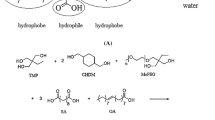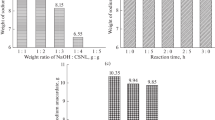Abstract
Palm oil-based polymeric surfactants of anionic and non-ionic charges, AS1 and NS1, were successfully synthesized via polyesterification reaction. Both AS1 and NS1 demonstrated limited solubility in aqueous medium. Surfactant solutions were prepared before adding into the partially de-ammoniated HA latex. The efficiency of these surfactants as latex stabilizers was evaluated in a 2-week short-term-stability study. AS1 showed greater potential in stabilizing the partially de-ammoniated HA latex compared to NS1. Further study was conducted to investigate the minimum amount of AS1 needed for stabilizing latex concentrate up to 6-month long-term storage. AS1 of 0.6 wt% showed higher latex stabilization ability by maintaining VFA no. < 0.035, MST at 1800s, alkalinity ≤ 0.2, pH at 11, viscosity < 70 cps and particle size < 0.7 μm for up to 6-month storage. It was postulated that AS1 could induce both steric and electrostatic stabilization mechanisms to stabilize latex particles in its aqueous medium. These results provide a useful reference to understand the performance of non-cytotoxic palm-based surfactant in latex stabilization system.



















Similar content being viewed by others
References
Tarachiwin L, Sakdapipanich J, Ute K, Kitayama T, Tanaka Y (2005) Structural characterization of α-terminal group of natural rubber. 2. Decomposition of branch-points by phospholipase and chemical treatments. Biomacromol 6:1858–1863
Salomez M, Subileau M, Intapun J, Bonfils F, Sainte-Beuve J, Vaysse L et al (2014) Micro-organisms in latex and natural rubber coagula of Hevea brasiliensis and their impact on rubber composition, structure and properties. J Appl Microbiol 117:921–929
Kumarn S, Churinthorn N, Nimpaiboon A, Sriring M, Ho CC, Takahara A et al (2018) Investigating the mechanistic and structural role of lipid hydrolysis in the stabilization of ammonia-preserved Hevea rubber latex. Langmuir 34:12730–12738
Santipanusopon S, Riyajan SA (2009) Effect of field natural rubber latex with different ammonia contents and storage periods on physical properties of latex concentrate, stability of skim latex and dipped film. Phys Procedia 2:127–134
Yari S, Asadi AF, Varmazyar S (2016) Assessment of semi-quantitative health risks of exposure to harmful chemical agents in the context of carcinogenesis in the latex glove manufacturing industry. Asian Pac J Cancer Prev 17:205–211
Ahonen EQ, Lopez-Jacob MJ, Vazquez ML, Porthé V, Gil-González D, García AM et al (2009) Invisible work, unseen hazards: the health of woman immigrant household service workers in Spain. Am J Ind Med 53:405–416
Quinn MM, Henneberger PK, Braun B, Delclos GL, Fagan K, Huang V et al (2015) Cleaning and disinfecting environmental surfaces in health care: toward an integrated framework for infection and occupational illness prevention. Am J Infect Control 43:424–434
Mendes A, Madureira J, Neves P, Carvalhais C, Neves P, Laffon B, Teixeira JP (2011) Chemical exposure and occupational symptoms among Portuguese hairdressers. J Toxicol Environ Health, Part A 74:993–1000
Haldeman JL. Stabilizer for low ammonia natural rubber latex compounds. Patent 4,455,265, USA, 1984.
Tarachiwin L, Sakdapipanich JT, Tanaka Y (2003) Gel formation in natural rubber latex: 1. Effect of (NH4)2HPO4 And TMTD/ZnO additives. Rubb Chem Technol 76:1178–1184
Sirisomboon P, Lim CH (2019) Rapid evaluation of the properties of natural rubber latex and its products using near-infrared spectroscopy. IntechOpen; 1–18.
Virdi R, Grover B, Ghuman K (2019) ‘“Nitrosamine safe”’ thiuram disulfide. Rubb Chem Technol 92(1):90–109
Joseph AM, George B, Madhusoodanan KN, Alex R (2015) Current status of sulphur vulcanization and devulcanization chemistry: process of vulcanization. Rubber Sci 28(1):82–121
Gholami H, Yeganeh H, Burujeny S, Sorayya M, Shams E (2017) Vegetable oil based polyurethane containing 1,2,3-triazolium functional groups as antimicrobial wound dressing. J Polym Environ 26:462–473
Narute P, Rao GR, Misra S, Palanisamy A (2015) Modification of cottonseed oil for amine cured epoxy resin: Studies on thermomechanical, physico-chemical, morphological and antimicrobial properties. Prog Org Coat 88:316–324
Diez-Pascual AM, Diez-Vicente AL (2015) Development of linseed oil-TiO2 green nanocomposites as antimicrobial coatings. J Mater Chem B 3:4458–4471
Lee SY, Koh RY, Liew YK, Som FM, Yatim AHM, Mok KL (2018) Novel palm oil based polymeric surfactant in natural rubber latex films. In: 9th international rubber glove conference and exhibition 2018, Kuala Lumpur, Malaysia, 4 Sep-6 Sep 2018.
Lee SY, Ling YTQ, Heng YX (2019) An environment-friendly palm fatty acid-based polymeric surfactants for coating applications: physicochemical, surface tension and low-foaming properties. J Polym Environ 27:2707–2719
Spilman GE, Young TJ, Sandoval RW, Ortiz RS, Beebe MC, Madkour A Reactive alkyd surfactant and stable emulsions made therefrom. Patent 2014/0221561 A1, USA, 2014.
Narongwongwattana S, Rittiron R, Lim C (2015) The rapid determination of volatile fatty acid number in para rubber latex using fourier transform-near infrared spectroscopy based on quantification and discrimination model. J Innov Opt Health Sci 08(05):1550042
Afreen S, Haque K, Huda M (2013) Troubleshooting for the observed problems in processing latex concentrate from natural resource. IOP Conf Ser 16(012007):1–4
Peres J, Pastore F (2019) Amazon rubber, a potential yet to be rediscovered. J Polym Environ 27(3):652–658
Ong CW, Bahri ARS (2016) Rubber particles: size, molecular weight and their distributions detected in wild Hevea species. J Biol Agric Healthcare 6:98–103
Tadros TF (2005) Applied surfactants: principles and applications. Wiley-VCH Verlag GmbH & Co. KGaA, Weinheim, pp 1–634
Kumara PHS, Prasad AKDW, Rohanadeepa VCH (2012) Blending of high VFA latex concentrate with low VFA latex concentrate. J Rubb Res 15:96–110
Acknowledgements
The authors would like to thank the Malaysian Rubber Board for the research funding (S17STL0663) and permission to publish this paper. Mr. Abdul Yazib Bakar and Mr. Muhammad Saiffdin Nordin are acknowledged for their excellent technical assistance.
Author information
Authors and Affiliations
Corresponding author
Ethics declarations
Conflicting interests
The author(s) declared no potential conflicts of interest with respect to the research, authorship, and/or publication of this article.
Additional information
Publisher's Note
Springer Nature remains neutral with regard to jurisdictional claims in published maps and institutional affiliations.
Rights and permissions
About this article
Cite this article
Lee, S.Y., Heng, Y.X., Ling, Y.T.Q. et al. Non-cytotoxic palm-based polymeric surfactant as a green stabilizer in natural rubber latex. J Rubber Res 24, 423–433 (2021). https://doi.org/10.1007/s42464-021-00111-w
Received:
Accepted:
Published:
Issue Date:
DOI: https://doi.org/10.1007/s42464-021-00111-w




